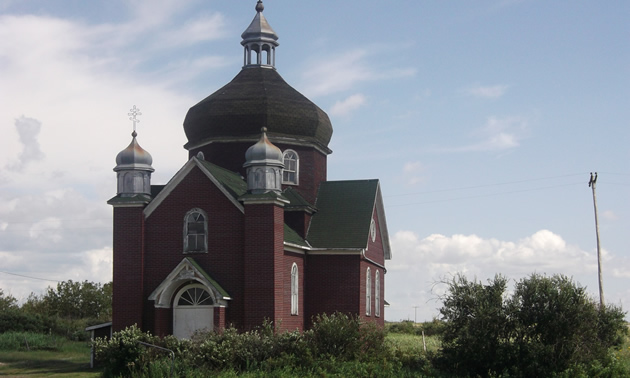Unfathomable! I was somewhat saddened that all the planning and excitement, and what turned out to be the most meaningful motorcycle trip of my life, was almost over. We had to backtrack on the same highway but we didn't tire of the ruggedness and beauty of Newfoundland.
As we headed westbound across the Avalon Peninsula, the crosswinds beat us up once again. The weather forecast was grim, as if our spirits weren't already dampened. We didn’t stay in a tent that night but instead, we stayed in a motel in Gander near the Aviation Museum. It rained all night long and I knew that we were in for a nasty ride.
Heading home
It poured on us the next day and it turned cool but we had the gear. It wasn't our best morning, but we rode it out and into the sunshine within several hours. I noted more eye-catching signs with directions to Big Steady and Harbour Deep. As we neared a childhood home for Bruce we took a quick side trip south into Howley. It was beautiful.
Once more, we were privy to the view of the same mountain ranges we had seen before as we closed in on the ferry at Channel-Port aux Basques. It came hand-in-hand as we rode through the Codroy Valley. We passed wind warning signage, cautioning that 200-kilometre gusts were possible, and we again had to battle unfathomable crosswinds—which are referred to as "wreckhouse winds" by some.
As we navigated through the Table Mountains and into Port aux Basques it became foggy and the visibility was poor. We had another wait for the ferry and a night crossing ahead of us. We were grouped together with many bikers—about 20 or more who were all sharing in their adventures. I stood back and watched as many were amazed at Bruce's gusto.
For Bruce, Prince Edward Island is home and for me, it is my birthplace. We were a mere 360 scenic kilometres away, with an easy 45-minute ferry ride thrown in. We arrived early in the afternoon and it was the end of the line for Bruce, at 9,550 kilometres. We were eager to check our lottery tickets, hoping our plan had made us winners. We had purchased 649 lottery tickets in every province, but now it’s official—we are "losers" in all 10 Canadian provinces. It's only money. We achieved a lot, however, and thought we were winners because we went on such a delightful trip.
My wife, Judy, was already on the Island, arriving from Victoria, B.C., three weeks prior. We visited friends, enjoyed the ocean views and I pigged out on a bounty of fresh local seafood—even available while "in season" at many popular fast food restaurants. Of course Mum's home-cooked scallops were to die for.
Apples and oranges
Day No. 1, now heading home. My rear passenger was now opposite to Bruce, and she had different needs. News flash: men and women are different; however, Judy and I shared similar joy, camaraderie and laughs as did Bruce and I. Judy had a timeline I could not meet though—she would fly out of Winnipeg. I changed things up for different scenery and to shave kilometres. Our heading was Riviere-du-Loup, Quebec, and we were anxious to see and sail across the St. Lawrence Seaway to St. Simeon, Quebec.
We couldn't run and we couldn't hide
The temperature was 30º C, it was sunny, hot and humid and we were enjoying the moment. Not true to my form, I was in a T-shirt and shorts. I always check the weather and the following was not in the forecast.
Near Grand Falls, New Brunswick, as quick as a light switch, we rounded a corner and the skies were hockey puck black, the clouds menacing and the rain light. The temperature dropped from 30º C to 19º C in a heartbeat. We pulled off immediately and suited up for the inevitable, and within minutes the skies opened up. Traffic seemed to halt. If you've ever been in that downpour when most cars pull to the side and stop with their four-ways on to wait it out, this was it. Visibility was worrisome and I wanted to stop but we had nowhere to go. I pleaded to myself for an overpass that didn't come. With the four-ways on, we rode between 55 to 60 kilometres per hour on the Trans-Canada Highway and only one car passed us. A car stayed behind us with its four-ways on for many kilometres and that was reassuring; it seemed that car was sheltering us.
There was lightning overhead and the thunder seemed immediate, its roar deafening. I could feel the concussion from the thunder in my chest. After one sudden clap of thunder, Judy screamed to the top of her lungs, flung herself forward and wrapped her arms around me. I don't get startled often but I was frightened. What if we got hit by lightning? My instinct then was to pull over, get off the bike, walk into the ditch and take a good soaking.
Surviving the storm
Like magic and within seconds, we rode out of that storm, into the sun and the roads became dry. The car that had been sheltering us slowly passed and we waved to one another. This was by far the most alarming storm I have ever experienced in many years on a motorcycle. I would guess we were into it for no more than 10 to 15 agonizing minutes. We continued, knowing the sun and wind would dry us quickly.
Without further adieu, we reached our goal: the ferry at Riviere-du-Loup. The trip through that city and the ferry ride were delightful. As is always the case, we shared our adventure with other bikers on board.
The St. Lawrence River is huge and our crossing took 90 minutes for 22 kilometres. After 760 kilometres, we eagerly crawled into our tent in St. Simeon, not knowing we were to get rained on overnight and into the morning, meaning we would pack up a wet tent.
Not to reinvent the wheel
The early morning rain only lasted for half an hour, lifting our spirits. Our trip west through Quebec was again beautiful. West of Hearst, Ontario, on a deserted section of Highway No. 11, a cow moose and calf seemed to be spooked and they were on a full run headed towards the highway. Slight acceleration moved us out of harm's way and the animals turned and disappeared into the bush.
We hit some outrageous gas prices in the Upsala, Ontario, area: $1.49 per litre for regular. Inadvertently, or perhaps luckily for us, I missed bypass No. 17A and rode through Kenora. It is a beautiful city with endless views of the water. It was sad, however, that just west of Kenora—where we had passed by a horrific scene three weeks prior where a motorcyclist had been killed—there was now a roadside memorial.
Not to reinvent the wheel but we backtracked to the Manitoba border. At that point, we didn’t take any more backroads and headed west on the Trans-Canada into Winnipeg, where Judy would board a plane for Edmonton, Alberta, the next morning.
Riding solo
Webster's definition of solo: unaccompanied or alone. For the last 1,300 kilometres I was on my own. The solo motorcycle experience can be very rewarding, relaxing and a great time for self-reflection.
For the next two days I again thoroughly enjoyed the Prairies with the canola fields, and was offended occasionally by that sweet smell of loaded livestock haulers and manure. It was hot and cattle were up to their bellies in water or in the shade to cool off. While I was riding out of a gas station in Manitoba, a stranger held his hand out the window of his car to stop me. He cautioned me against heading north due to another huge storm.
There was smoke in the sky as I approached Yorkton, Saskatchewan, from the east on Highway 16. It became obvious very quickly that a vehicle was on fire on my side of the highway. There was no approaching traffic so I slowed and took a wide swing around. It was a pickup truck totally engulfed in fire. As I passed something ignited and blew up and it made a huge popping sound. I was one of the first to stop. It turned out that the driver had escaped and there were no injuries. I left as a fire truck arrived.
Alone in my thoughts, on a flat, desolate stretch of the Yellowhead Highway near Foam Lake, Saskatchewan, I was attentive to a lumbering eastbound freight train that was close to the highway. Sometimes it works and sometimes it doesn't. With cruise control on, as the train neared me, I looked towards the locomotive’s windows, raised my right arm high and simulated a pulling-down motion as if sounding the air horn on a large truck, or the like. The train conductor acknowledged my efforts and signalled two blasts on the air horn. That small gesture by the train crew was uplifting. That night, I tented in Lanigan, Saskatchewan, with one more day to go.
Feeling the heat
The next morning, it was hot and a Saskatoon radio station reported the humidity to be 98 per cent and that a mosquito warning was in effect. The fields were saturated in water and it seemed to be birds everywhere. It was disturbing that several times I noted skid marks on the roadway and the resultant lifeless moose carcasses in a heap on the shoulder.
A pleasant greeting: a sign that said, “LLoydminster, Canada's Border City.” I was almost home and had found my second wind. Most vehicles were displaying Alberta licence plates and I noted many trucks hauling amusement rides and concession stands as they passed me heading east. I knew that Edmonton's annual fair was over and I entered Edmonton without fanfare.
We did it—the good, the bad and the ugly
Bruce and I did something together that neither one of us will ever forget as long as we both shall live. He displayed such fortitude and we laughed like schoolboys throughout the journey.
We did see the good, the bad and the ugly, and I am happy to report that the good prevailed. The beauty of this country experienced on a motorcycle, the togetherness I felt with Bruce and Judy, slowing life down and stopping to smell the roses, the friendliness of strangers and even train crews is what this was all about.
On the end of my finger, I tasted the salty water of both oceans—their taste and texture was the same. The rainwater on Vancouver Island and on the island of Newfoundland was the same: wet and necessary. The winds from both oceans were similarly uncomfortable, but that's nature.
Thank you to Tony at Riverside Honda and Ski-Doo for checking up on us during our travels and thank you to all at Riverside for ensuring my Goldwing performed flawlessly—we couldn't have had a better ride.
Would I do it again? Absolutely, but I would allow more time. There is just so much to see and enjoy. What would I do different? I don't know. I'm not sure what next season will bring. I will have a long Alberta winter to dream something up. Bruce, what's next?








Comments